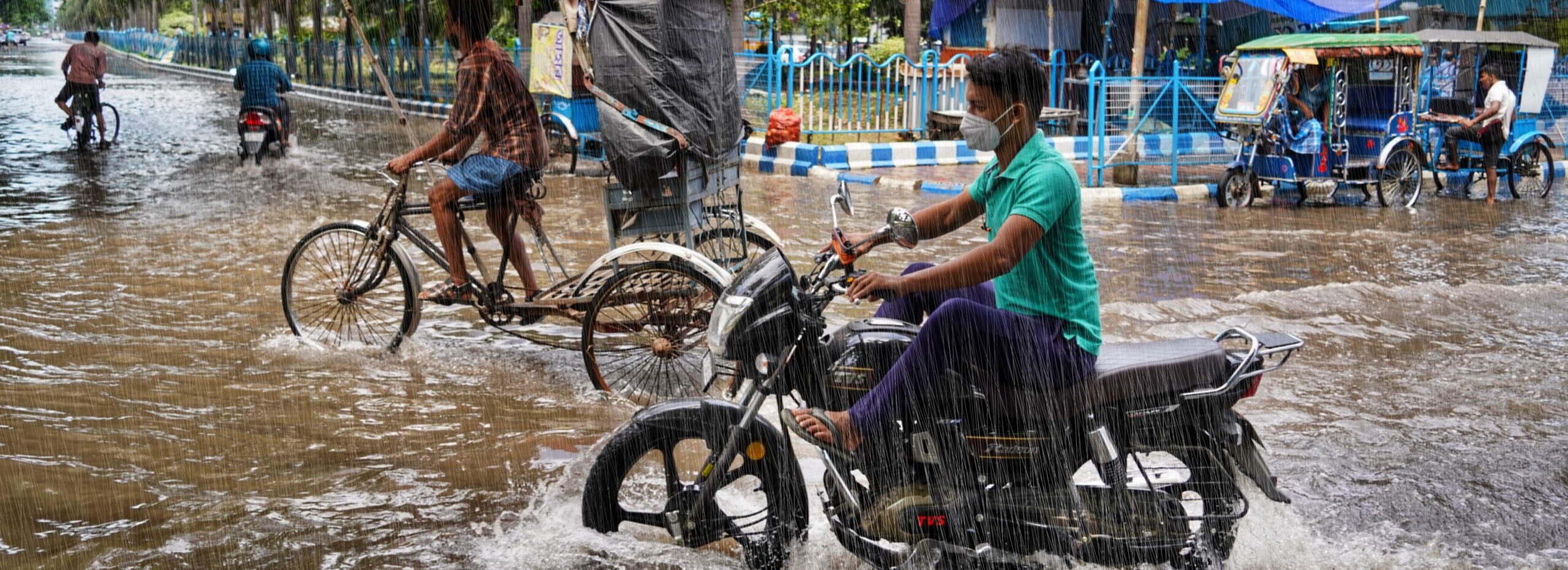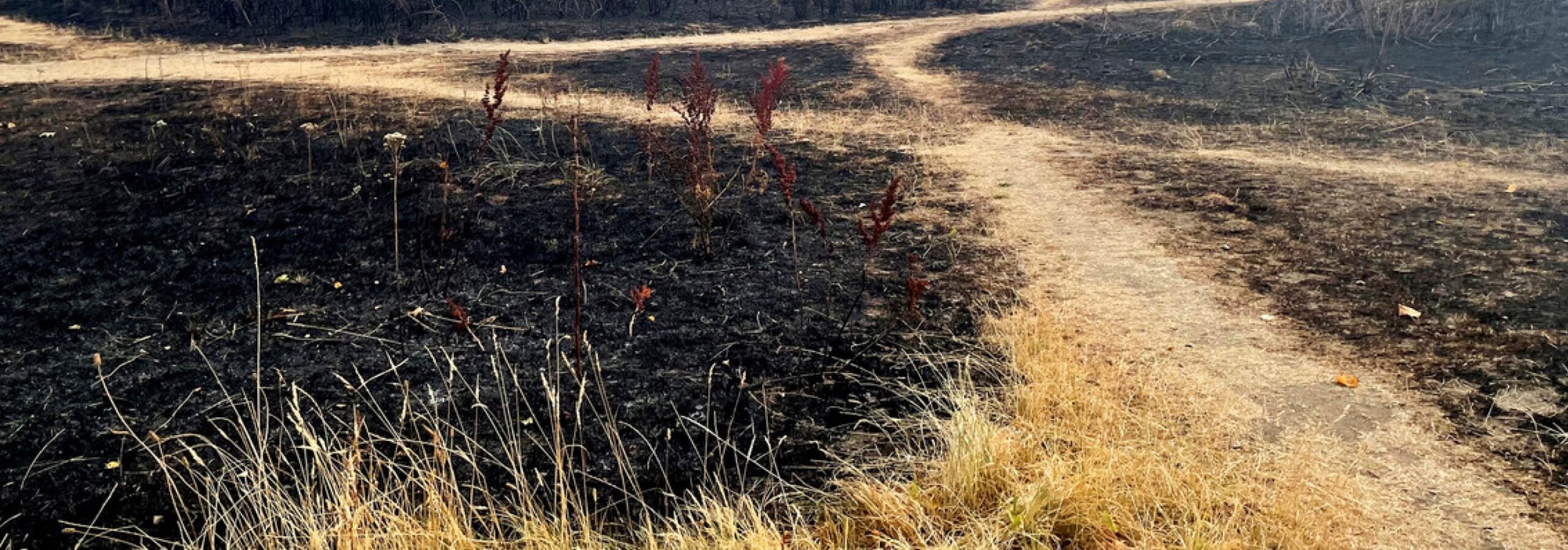Southern Europe was unusually wet, with damaging thunderstorms in France in the first half of June. In this analysis we investigate the connection between one aspect, the highest temperatures so far in Northern Europe, and climate change.
Aspects other than temperature are much less straightforward to analyse but may be considered in subsequent studies. It is important to note that, compared to other attribution analyses of European summers, attributing a heatwave early in the season with the whole of August still to come will only give a preliminary result of the 2018 Northern hemisphere heatwave season.
Here we present an attribution study of the ongoing heat wave made in near real time using well assessed methodologies. It is not peer-reviewed and was written quickly. We used thoroughly tested methods to do the analysis, evaluation of models and checked the observations for errors. The return times are partly based on forecasts and therefore have additional uncertainties. However, the changes in probability are based on past observations and model results, and the authors are confident that these results are robust. We are very grateful to Peter Thorne and Peter Thejll for making the Irish (from Met Eiréann) and Danish (from DMI) temperature observations available to us.
Key findings
- The heat (based on observations and forecast) is very extreme near the Arctic circle, but less extreme further south: return periods are about 10 years in southern Scandinavia and Ireland, five years in the Netherlands
- From past observations and models we find that the probability of such a heatwave to occur has increased everywhere in this region due to anthropogenic climate change, although in Scandinavia this increase was not visible in observations until now due to the very variable summer weather.
- We estimate that the probability to have such a heat or higher is generally more than two times higher today than if human activities had not altered climate.
- Due to the underlying warming trend even record breaking events can be not very extreme but have relatively low return times in the current climate.
- With global mean temperatures continuing to increase heat waves like this will become even less exceptional
Here we present an attribution study of the ongoing heat wave made in near real time using well assessed methodologies. It is not peer-reviewed and was written quickly. We used thoroughly tested methods to do the analysis, evaluation of models and checked the observations for errors. The return times are partly based on forecasts and therefore have additional uncertainties. However, the changes in probability are based on past observations and model results and the authors are confident that these results are robust. We are very grateful to Peter Thorne and Peter Thejll for making the Irish (from Met Eiréann) and Danish (from DMI) temperature observations available to us.
Introduction
The summer of 2018 has been remarkable in northern Europe. A very persistent high-pressure anomaly over Scandinavia (Figure 1a) caused high temperature anomalies and drought there from May to (at least) July (Figures 1b,c). These reached as far southwest as Ireland. Southern Europe was unusually wet, with damaging thunderstorms in France in the first half of June. In this analysis we investigate the connection between one aspect, the highest temperatures so far in Northern Europe, and climate change. Aspects other than temperature are much less straightforward to analyse but may be considered in subsequent studies. It is important to note that, compared to other attribution analyses of European summers, attributing a heat wave early in the season with the whole of August still to come will only give a preliminary result of the 2018 Northern hemisphere heatwave season.

The analysis is based on observations from the 1st of May up to 24 July plus 5-day forecasts from the ECMWF deterministic model. In fact, the hottest days of the summer so far are occurring as we do the analysis, so most results are based on one- to three day forecasts. Experience has shown these to be accurate enough. For relatively common events, the change in probability that we compute is not very sensitive to the exact temperature of the event. In this analysis that applies to all areas except the most northern one, where we take the uncertainty due to the forecast into account.
Event definition
To define the event, we analyse the three-day maximum temperature average (TX3x) at individual locations. In most of the locations the three-day heat waves were actually not extremely hot in the current climate, so the return time of the event at each place is small and the event we look at is not very extreme. The persistence of the heat is probably the more exceptional factor in this summer’s heat waves, but changing the definition from three to seven does not change the return time much. Looking at even longer events would probably lead to a definition of a rarer event, however long temporal averages would also lead to much less data to analyse in the observations and thus to higher uncertainties. Therefore we chose to use the 3-day maximum average, which also facilitates comparison with previous analyses, even though longer time scales would show a stronger connection to global warming.
Figure 2 shows the anomaly of the 2018 summer in this measure, i.e., the highest value for the summer so far compared to the normal highest value of the summer. It shows that the highest anomalies were in northern Scandinavia and in western Ireland, with heat waves already more than five degrees warmer than the average hottest three days of the year in 1981-2010. The Netherlands are also experiencing a heat wave that is forecast to be about three degrees warmer than normal in the 3-day running mean. Note that we expect this map to show more red areas after the summer, because there could well be hotter periods in August than the ones shown.

Based on this map, we are focusing on Northern Europe and analyse the following stations with long, homogeneous records and preferably not too close to coasts in order to enable comparisons with climate models:
- Phoenix Park (Dublin, Ireland, 53.36N, -6.32E, 49.0m),
- De Bilt (Netherlands, 52.10N, 5.18E, 1.9m),
- Landbohøjskolen (Copenhagen, Denmark, 55.7N; 12.5E, 9m),
- Oslo Blindern (Norway, 59.94N, 10.72E, 94.0m),
- Linköping (Sweden, 58.40N, 15.53E, 93.0m),
- Sodankyla (Finland, 67.37N, 26.63E, 179.0m) and
- Jokioinen (Finland, 60.81N, 23.50E, 104.0m).
Methods
In this article we do not analyse large area averages or country averages as in previous analyses of high temperatures but focus instead on a number of individual locations in Northern Europe where long records of observed data are available.
We firstly analyze observed temperatures and estimate how rare the current heat wave is, measured as three-day maximum temperatures, and whether or not there is a trend toward increasing temperature. As appropriate for our event definition, we fit a Generalized Extreme Value Distribution (GEV), described by three parameters: the position parameter μ, the scale parameter σ and the shape parameter ξ. In this statistical approach, global warming is factored in by allowing the fit to the distribution to be a function of the (low-pass filtered) global mean surface temperature (GMST), where GMST is taken from the National Aeronautics and Space Administration (NASA) Goddard Institute for Space Science (GISS) surface temperature analysis (GISTEMP, Hansen et al., 2010). We assume that the scale parameter σ shifts with the position parameter μ, thus the PDF is shifted up or down with GMST but does not change shape. In this way, it results in a distribution that varies continuously with GMST. This distribution can be evaluated for a GMST in the past (e.g., 1950 or 1900) and for the current GMST. A 1000-member non-parametric bootstrap procedure is used to estimate confidence intervals for the fit.
We can then assess the probability of occurrence of the observed event in the present climate, p1, and past climate, p0. These probabilities are communicated as return periods of the event in the present and past: 1/p1 and 1/p0 respectively. The risk ratio is evaluated as the ratio of p1 to p0. If the 95% confidence interval for risk ratio does not encompass unity, we say that the risk ratio is significantly larger (or smaller) than one and there is a detectable positive (or negative) trend in the observational data. This approach has been used before, e.g., Philip et al. (2017) for drought, Schaller et al. (2014) and van der Wiel et al. (2017) for heavy precipitation, Uhe et al. (2016) and van Oldenborgh et al. (2015) for temperature, and Vautard et al. (2017) for wind stagnation.
Secondly, to assess the role of climate change, we compare observations with results from climate models that are available and suitable for the temperatures in these locations. This answers the question whether and to what extent external drivers, in particular human-caused climate change, can explain the temperature trends in the observational data. Including models allows us to give the causation of a trend. Models included in this analysis are EC-Earth 2.3 T159 (1861-2100, ~150km resolution), RACMO 2.2 (1950-2100, ~12km) HadGem3-A N219 (1960-2015, ~60km), and weather@home (HadRM3, ~25km). A more detailed description of these models can be found below.
In all cases we use the approximate return time of the event as found in the observations as the event definition for analysis. For transient simulations of the changing climate, we again calculate how the probability of the event is changing over time in the model data, by fitting the temperature values to a distribution that shifts proportional to the smoothed global mean temperature. This method assumes that global warming is the main factor affecting local temperatures since about 1900, and that virtually all global warming is attributable to anthropogenic factors. In Europe, with very little decadal variability, the first condition is met. The second assumption is the conclusion of the IPCC, but disregards the uncertainty surrounding it (IPCC WG1 AR5 Chapter 10). For the weather@home model we use the more straightforward method of directly comparing an experiment with actual conditions to another one that represents pre-industrial conditions. The change in the likelihood of the event occurring due to the change in climate (the risk ratio) is calculated from the (fitted) distributions for the current climate and a past climate. For the EURO-CORDEX climate projections ensemble, we pool 11 regional climate model simulations, which is a method that was used in previous cases.
Models that show significantly different behaviour of hot events from the observations are not considered further. To assess this behaviour, we investigate whether the fit parameters to the GEV differ significantly, allowing for an additive bias correction. In practice it means we demand that the variability of hot extremes is compatible with the observed variability, a condition which is not always met (cf our analysis of the 2017 heat wave in the Mediterranean).
Finally, we synthesise the results from observations and climate models that have passed our evaluation in order to assess whether the overall change in likelihood of the event occurring is attributable to anthropogenic climate change.
Observational analysis
For every station we fit the statistical model described in section 3 and determine the return time and whether a trend emerges beyond the range of deviations expected by natural variability. In the table below we summarise the results of the return period for each station that has been analysed. Risk Ratio and change in temperature are summarised below together with the model results.
| Station | Length of time series | Observed or forecast value (Celsius) | Return period in current climate (yr) |
| Dublin, Ireland | 1880-2018 | 26.5 | 8 (4…15) |
| De Bilt, Netherlands | 1900-2018 | 33.0 | 5 (3…9) |
| Copenhagen, Denmark | 1874-2018 | 30.9 | 7 (4…19) |
| Oslo, Norway | 1937-2018 | 31.2 | 8 (3…30) |
| Linköping, Sweden | 1931-2018 | 32.2 | 30 (10…200) |
| Sodankyla, northern Finland | 1908-2018 | 31.9 | >90 yr |
| Jokioinen, southern Finland | 1957-2018 | 32.1 | 140 (>16) |
We use the best guess of these return times in three day maximum temperatures as the event definition for the gridpoint in the climate models the station is located in.
Model analysis
At each location we calculate the risk ratio as well as the change in magnitude of the event in the observations and the models. If the variability is “too large” or “too small” we do not use the results. For the two Finnish stations EC-Earth was used instead of RACMO as they fall outside the RACMO domain. We synthesise the others with the observations to give an overarching attribution statement.
| Data set | Variability (reason why not used) | Risk Ratio (p1/p0) |
| Ireland: Dublin Phoenix Park | ||
| Station | 1.9 (0.9…4.2) | |
| RACMO | OK | 2.0 (1.6…2.6) |
| HadGEM-3A | too low | 40 (16 … 235) |
| weather@home | too high | 2.3 (1.4 … 3.9) |
| EUROCORDEX | slightly too high | 2.0 (1.5 … 2.9) |
| Synthesis | 2.0 (1.2 … 3.3) | |
| Netherlands: De Bilt | ||
| Station | 20 (6…500) | |
| RACMO | OK | 1.6 (1.2 … 2.1) |
| HadGEM3-A | OK | 1.4 (1.0 … 1.7) |
| weather@home | too large | 2.5 (1.2 … 4.2) |
| EUROCORDEX | slightly too large | 2.5 (1.9 … 4.1) |
| Synthesis | 3.3 (1.6 … 16) | |
| Denmark: Copenhagen Landbohøjskolen | ||
| Station | 3 (1.2…9) | |
| RACMO | OK | 4.1 (2.2 … 7.7) |
| HadGEM3-A | OK | 10 (5.6 … 24) |
| weather@home | too large | 1.8 (1.3 … 2.6) |
| EUROCORDEX | too large | 1.9 (1.5 … 2.4) |
| Synthesis | 5.0 (2.4 … 12) | |
| Norway: Oslo Blindern | ||
| Station | 1.6 (0.3…10) | |
| RACMO | OK | 3.6 (2.2 … 6.7) |
| HadGEM3-A | too low | 6.9 (4.5 … 12) |
| weather@home | too large | 1.6 (1.3 … 2.0) |
| EUROCORDEX | OK | 4.6 (2.3 … 10) |
| Synthesis | 3.0 (1.0 … 10) | |
| Sweden: Linköping | ||
| Station | 1.1 (0.2…9) | |
| RACMO | OK | 4.1 (2.3 … 10) |
| HadGEM3-A | OK | 11 (5.7… 39) |
| weather@home | too large | 2.0 (1.4 … 2.9) |
| EUROCORDEX | OK | 30 (22 … 44) |
| Synthesis | 6 (2.2 … 23) | |
| Finland: Sodankyla | ||
| Station | 0.0002…20 | |
| EC-Earth | OK | 150 (12 … 1500) |
| HadGEM3-A | OK | 80 (5 … 5000) |
| weather@home | too large | 2.7 (1.3 … 6.8) |
| EUROCORDEX | OK | >1000 |
| Synthesis | not possible | |
| Finland: Jokioinen | ||
| Station | 1.8 (0.2…∞) | |
| EC-Earth | OK | 4.5 (3.0 … 6.5) |
| HadGEM3-A | OK | 7.7 (5.4 … 27) |
| weather@home | too large | 2.4 (1.7 … 3.4) |
| EUROCORDEX | OK | 100 (34 … 200) |
| Synthesis | not possible | |
Synthesis
Dublin Phoenix Park
Only two models had variability compatible with the observations (EUROCORDEX has 30% too much variability but we decided to keep it; EC-Earth is fine but is also downscaled by RACMO, which fits the observations even better). The Risk Ratio is about two in all estimates, the straight average of observations and the two models gives a Risk Ratio of 2.0 with a 95% uncertainty interval of 1.2 … 3.3.

De Bilt
Observations show a much bigger increase in probability than the models, which also show some spreads. We verified that the trend is the same at the other homogenised non-coastal stations in the Netherlands (Eelde and Maastricht). Starting in 1951, and hence avoiding the breaks altogether, gives even higher trends and hence Risk Ratios. The same mismatch extends into Central Europe and has been discussed by Min et al., 2012 and Sippel et al., 2016. The cause is as yet unknown, so the best we can do at this moment is to average these values (on a logarithmic scale) leading to an increase in probability of very roughly a factor three, and definitely larger than one.

Copenhagen Landbohøjskolen
Both models with variability that is compatible with the observations show a somewhat stronger increase than the observed trend, but within uncertainties the results are reasonably compatible (χ²/dof=3.4). The average Risk ratio is roughly five (larger than 2.4).

Oslo Blindern
The observed trend has large uncertainties and is therefore compatible with both models that have realistic variability. The two models with realistic variability agree well. The average gives a Risk Ratio between 1 and 10, so we can say that the probability increased but not very well by how much.

Linköping (Sweden)
Again there is huge uncertainty in the observed trend. The EUROCORDEX ensemble has a higher trend than the other two models, so we cannot say much more than there is definitely an increase in probability for heatwaves.

Sodankyla
In the high Arctic, the uncertainties both on the observations and on the climate models are enormous. Given the strong positive trends in the climate models, and the possibility of a positive trend in the observations, we can state that the trend is positive but nothing more. Note that the scale extends over eight orders of magnitude.

Jokioinen
The same holds for the more southerly station in Finland.

Conclusion
In our analysis we have looked at local weather stations in northern Europe where people are experiencing the heat wave today. In individual locations the interannual variability in summer temperatures is much larger than if we would average over countries or the whole region that is experiencing a heat wave in the early summer of 2018. The climate change signal is thus harder to detect from the noise in individual places. However, it is towns and villages where people live and not area averages, hence we chose to focus on stations only in this analysis. In previous studies we have compared stations with large scale averages where we found e.g. that in the case of last year’s heatwave in the South of Europe the increase in the occurrence likelihood of a heat wave like the one observed was at least a factor two larger in the area average than at individual stations.
In Ireland, the Netherlands and Denmark there are clear trends towards more heat waves in the observations. In Ireland and Denmark climate models give a very similar increase in probabilities to the observations — roughly a factor two more likely in Dublin and a factor four in Denmark. In the Netherlands the observed increase in hot extremes is much larger than the modelled increase. This is a well-known problem (Min et al, 2013, Sippel et al, 2016) but the cause has not yet been elucidated.
However, this is not the case further north. No trend is currently detectable in the observations there. However, due to the large variability of the summer weather, the uncertainty in the trends is so large that the observations are also compatible with large changes in the likelihood of heat extremes to occur. In the case of Scandinavia, the models are thus probably a better source to estimate the change in likelihood as we have large ensembles of model experiments. However, due to the possibility of biases in the magnitude of the trend (as in Central Europe), we prefer not to give a number for the magnitude of the increase purely based on models. Thus, we can conclude that anthropogenic climate change increased the odds of a heat wave as observed in 2018 in Scandinavia but we cannot quantify by how much.
At the same time as an increase in noise, the further North in Europe we look, the more extreme the event is today. In the station in northern Finland, temperatures are experienced outside anything that has been measured before in over a hundred years worth of data. In Dublin and the Netherlands the 3-day average of maximum temperatures, measured this week (up to 28th of July) and forecast for the next, are fairly common for this time of the year in today’s climate, with return times between four and seven years even though they are close to record-high compared to earlier climates. They have simply become more likely due to anthropogenic climate change. In other words, you get record-high temperatures with a low return time if you have a large trend
Models
The following models are used in this analysis:
EC-Earth
EC-Earth 2.3 is a coupled atmosphere-ocean general circulation model ensemble with 16 members (Hazeleger et al. 2010), each producing a transient climate simulation from 1860 to 2100. The model resolution is T159 which translates to around 150 km in the European domain. The underlying scenarios are the historical CMIP5 protocols until the year 2005 and the RCP8.5 scenario (Taylor et al. 2012) from 2006 onwards. Up to about 2030, the historical and RCP8.5 temperature evolution is very similar.
RACMO
RACMO is a regional climate model developed at KNMI. An ensemble of sixteen members was generated to downscale the above-mentioned EC-Earth experiments over the period 1950-2100 at a resolution of about 11km (Lenderink et al., 2014, Aalbers et al., 2018).
HadGem3-A
The 15 HadGEM3-A atmosphere-only runs from 1960–2015 (Ciavarella et al, 2017) (N216, about 60km) are evaluated for the separate regions. The model is driven by observed forcings and sea-surface temperatures (SSTs) (“historical”) and with preindustrial forcings and SSTs from which the effect of climate change has been subtracted (“historicalNat”). The latter change has been estimated from the Coupled Model Intercomparison Project phase 5 (CMIP5) ensemble of coupled climate simulations.
weather@home
Using the distributed computing framework known as weather@home (Guillod et al., 2017, Massey et al., 2015) we simulate two different large ensembles of June and July weather, using the Met Office Hadley Centre regional climate model HadRM3P at 25km resolution over Europe embedded in the atmosphere-only global circulation model HadAM3P. The first set of ensembles represents possible weather under current climate conditions (prescribed OSTIA sea surface temperatures for 2006-2010). This ensemble is called the “all forcings” scenario and includes human-caused climate change. The second set of ensembles represents possible summer weather in a world as it might have been without anthropogenic climate drivers. This ensemble is called the “natural” or “counterfactual” scenario with prescribed sea surface temperatures obtained from CMIP5 simulations (Schaller et al., 2016).
EURO-CORDEX
We used the multi-model EURO-CORDEX ensemble (Jacob et al., 2014), including 11 different regional climate simulations at a 0.11° resolution over Europe. For this ensemble, an additional bias correction was applied (Bartok et al., in preparation) using the Cumulative Distribution Function transform (CDFt, Vrac et al., 2016) method. These simulations have been evaluated in the context of the CLIM4ENERGY Copernicus Climate Change Service project. The reference data used for bias correction is the Watch Forcing Data ERA-Interim (WFDEI, Weedon et al., 2014). The ensemble is pooled, which is formally possible because the bias correction method corrects data making it homogeneous across the multi-model distribution. However, caution must be taken when interpreting changes using such a pooled ensemble, as changes in the tails of the distribution may be different for each model, leading to potential heterogeneity in extremes for periods different than the reference period.
References
Aalbers, E. A., Lenderink, G., van Meijgaard, E., and van den Hurk, B. J. J. M. (2018) Local-scale changes in mean and heavy precipitation in Western Europe, climate change or internal variability? Climate Dynamics, 50: 4745. doi: 10.1007/s00382-017-3901-9
Ciavarella, A., Christidis, N., Andrews, M., Groenendijk, M., Rostron, J., Elkington, M., Burke, C., Lott, F.C., Stott, P.A. (2018) Upgrade of the HadGEM3-A based attribution system to high resolution and a new validation framework for probabilistic event attribution. Weather and Climate Extremes, 20 June 2018: 9–32. doi: 10.1016/j.wace.2018.03.003
D’Ippoliti, D., P. Michelozzi, C. Marino, de’Donato, F., Menne, B., Katsouyanni, K., Kirchmayer, U., Analitis, A., Medina-Ramón, M., Anna Paldy, A., Atkinson R., Kovats, S., Bisanti, L., Schneider, A., Lefranc, A., Iñiguez, C. and Perucci, C.A. (2010) The impact of heat waves on mortality in 9 European cities: Results from the EuroHEAT project. Environmental Health, 9: 37. doi: 10.1186/1476-069X-9-37
Guillod, B.P., Jones, R.G., Bowery, A., Haustein, K., Massey, N.R., Mitchell, D.M., Otto, F.E.L., Sparrow, S.N., Uhe, P., Wallom, D.C.H., Wilson, S. and Allen, M.R. (2017) weather@home 2: validation of an improved global – regional climate modelling system. Geoscientific Model Development, 10: 1849-1872
Hansen, J., R. Ruedy, M. Sato, and K. Lo. (2010) Global surface temperature change. Reviews of Geophysics, 48: RG4004. doi: 10.1029/2010RG000345
Hazeleger, W., C. Severijns, T. Semmler, S. Ştefănescu, S. Yang, X. Wang, K. Wyser, E. Dutra, J.M. Baldasano, R. Bintanja, P. Bougeault, R. Caballero, A.M. Ekman, J.H. Christensen, B. van den Hurk, P. Jimenez, C. Jones, P. Kållberg, T. Koenigk, R. McGrath, P. Miranda, T. Van Noije, T. Palmer, J.A. Parodi, T. Schmith, F. Selten, T. Storelvmo, A. Sterl, H. Tapamo, M. Vancoppenolle, P. Viterbo, and U. Willén. (2010) EC-Earth: A seamless Earth-system prediction approach in action. Bulletin of the American Meteorological Society, 91: 1357–1363. doi: 10.1175/2010BAMS2877.1
Lenderink, G., van den Hurk, B. J. J. M., Klein Tank, A. M. G., van Oldenborgh, G. J., van Meijgaard, E., de Vries H. and Beersma, J. J. (2014) Preparing local climate change scenarios for the Netherlands using resampling of climate model output. Environmental Research Letters, 9: 115008. doi: 10.1088/1748-9326/9/11/115008
Lewis, S. C., and D. J. Karoly. (2013) Anthropogenic contributions to Australia’s record summer temperatures of 2013. Geophysical Research Letters, 40: 3705–3709. doi: 10.1002/grl.50673
King, A. D., D. J. Karoly, and B. J. Henley. (2017) Australian climate extremes at 1.5 and 2 degrees of global warming. Nature Climate Change, 7, 412–416. doi: 10.1038/nclimate3296
Massey, N., Jones, R., Otto, F. E. L., Aina, T., Wilson, S., Murphy, J. M., Hassell, D., Yamazaki, Y. H. and Allen, M. R. (2015) weather@home— development and validation of a very large ensemble modelling system for probabilistic event attribution. Quarterly Journal of the Royal Meteorological Society, 141: 1528–1545. doi: 10.1002/qj.2455
Mitchell, D., AchutaRao, K., Allen, M., Bethke, I., Beyerle, U., Ciavarella, A., Forster, P. M., Fuglestvedt, J., Gillett, N., Haustein, K., Ingram, W., Iversen, T., Kharin, V., Klingaman, N., Massey, N., Fischer, E., Schleussner, C.-F., Scinocca, J., Seland, Ø., Shiogama, H., Shuckburgh, E., Sparrow, S., Stone, D., Uhe, P., Wallom, D., Wehner, M., and Zaaboul, R. (2017) Half a degree additional warming, prognosis and projected impacts (HAPPI): background and experimental design. Geoscientific Model Development, 10: 571-583. doi: 10.5194/gmd-10-571-2017.
Philip, S., Kew, S.F., van Oldenborgh, G.J., Otto, F., O’Keefe, S., Haustein, K., King, A., Zegeye A., Eshetu, Z., Hailemariam, K., Singh, R., Jjemba, E., Funk, C. and Cullen, H. (2017) Attribution analysis of the Ethiopian drought of 2015. Journal of Climate, 31: 2465–2486. doi.: 10.1175/JCLI-D-17-0274.1
Schaller, N., Kay, A.L., Lamb, R., Massey, N.R., van Oldenborgh, G.J., Otto, F.E.L., Sparrow, S.N., Vautard, R., Yiou, P., Bowery, A., Crooks, S.M., Huntingford, C., Ingram, W.J., Jones, R.G., Legg, T., Miller, J., Skeggs, J., Wallom, D., Weisheimer, A., Wilson, S. and Allen, M.R. (2016) The human influence on climate in the winter 2013/2014 floods in southern England. Nature Climate Change, 6, pages 627–634. doi: 10.1038/nclimate2927
Taylor, K. E., R. J. Stouffer, and G. A. Meehl. (2012) An overview of CMIP5 and the experiment 962 design. Bulletin of the American Meteorological Society, 93: 485–498. doi: 10.1175/BAMS-D-11-00094.1
Trewin, B. (2013) A daily homogenized temperature data set for Australia. International Journal of Climatology, 33: 1510–1529. doi: 10.1002/joc.3530
Min, E., Hazeleger, W., van Oldenborgh, G.J. and Sterl, A. (2013) Evaluation of trends in high temperature extremes in north-western Europe in regional climate models. Environmental Research Letters, 8: 014011, doi: 10.1088/1748-9326/8/1/014011
Sippel, S., Otto, F. E. L., Flach, M. and van Oldenborgh, G. J. (2016) The role of anthropogenic warming in 2015 Central European heat wave. Bulletin of the American Meteorological Society, 97, S51–S56, doi: 10.1175/BAMS-D-16-0150.1.
Uhe, P., Otto, F.E.L., Haustein, K., van Oldenborgh, G.J., King, A.D., Wallom, D.C.H., Allen, M.R. and Cullen, H. (2016) Comparison of methods: Attributing the 2014 record European temperatures to human influences. Geophysical Research Letters, 43(16): 8685-8693. doi: 10.1002/2016GL069568
Vautard, R., A. Colette, E. van Meijgaard, F. Meleux, G. J. van Oldenborgh, F. Otto, I. Tobin, P. Yiou. (2017) Attribution of wintertime anticyclonic stagnation contributing to air pollution in Western Europe. Bulletin of the American Meteorological Society, in Explaining extreme events of 2016 from a climate perspective, special supplement, S70-S75. doi: 10.1175/BAMS-D-17-0113.1
van Oldenborgh, G. J., R. Haarsma, H. De Vries, and M. R. Allen. (2015) Cold extremes in north america vs. mild weather in europe: The winter of 2013–14 in the context of a warming world. Bulletin of the American Meteorological Society, 96 (5): 707–714. doi 10.1175/BAMS-D-14-00036.1
Vrac, M., T. Noël, and R. Vautard. (2016) Bias correction of precipitation through Singularity Stochastic Removal: Because occurrences matter. Journal of Geophysical Research: Atmospheres, 121: 5237–5258. doi:10.1002/2015JD024511





